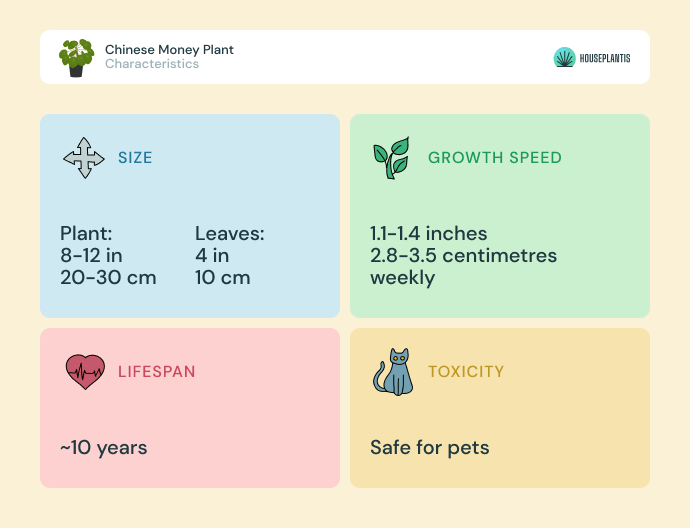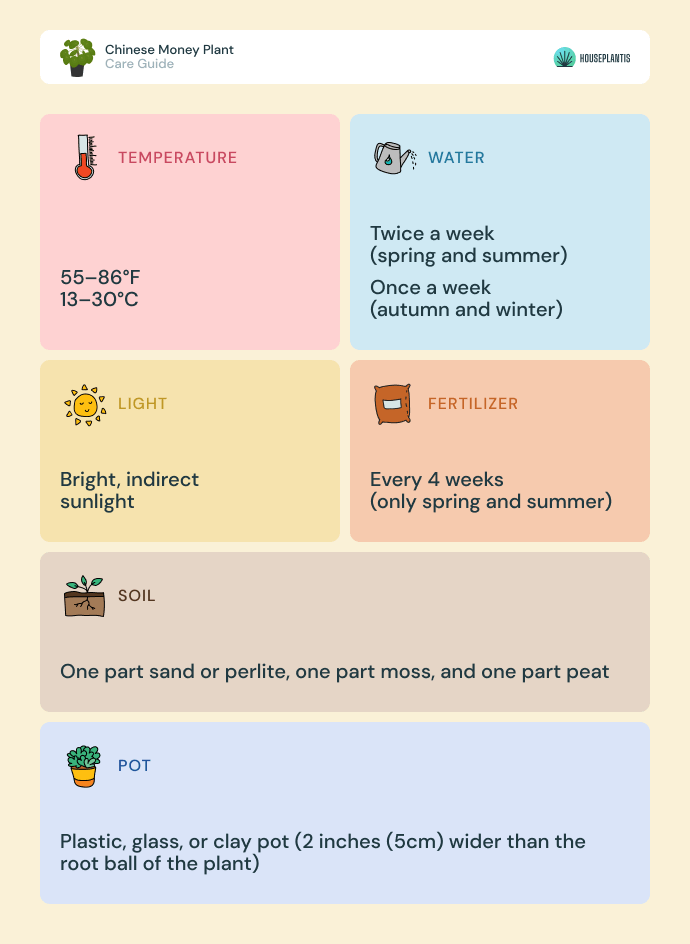Pilea pepperonides popularly known as the Chinese money plant or the missionary plant is a rare species that grows in the rocky forest of China. It is a perennial flowering plant is commonly used.
It belongs to the Urticaceae family (nettle) and is native to south China (Yunnan and Sichuan provinces). It has circular leaves (peltate) resembling novelsworth, with long petioles.
Table of Contents
Main Characteristics
How Big Does It Get?
Pilea doesn’t grow very tall. It is upright standing with 20-30cm (8-12 inches) height and an equivalent width. Its leaves grow up to 10cm (4 inches).
How Fast Does It Grow?
It grows double the size in about a year when exposed properly to light. It has a growth rate of approximately 2.8 – 3.5 cm (1.12 – 1.4 inches) weekly and reaches maturity at 9 months or a year.
How Long Does It Live?
Pilea has a minimum lifespan of 6 months and an average lifespan of 10 years. Sometimes, it can survive longer than that, up to 20 years.
Is It Toxic to Cats and Dogs?
It has no toxins, it’s safe around pets as well as children. There are other houseplants with such similarity, like the Christmas cactus. But you should keep your pets and kids off it. They are mischievous and can destroy your Chinese money.

Chinese Money Plant Care
How Often to Water
It requires moderate watering at least twice a week to keep the soil moist not mushy or waterlogged. During the winter (and other cooler months), the frequency of watering should be reduced to once a week to allow drying in between watering
Drainage
Draining a Pilea spp is similar to draining a peace lily plant. It is important to prevent waterlogging the soil and improving airflow. You need a pot with draining holes to achieve this, but be sure the holes are not too many.
Too many holes in your pot cause excess loss of water. 4-6 draining holes are ideal. If there are no holes, you can add a layer of pebble before adding soil.
Pruning
There are different reasons for trimming your Chinese money. It could be to remove dried or yellow leaves. You need clean and sharp tools to avoid any infection or damage.
Repotting
It is a moderate grower. It doubles in size every 12 months or so. It needs to be repotted bi-yearly or when the container gets too tight. To transplant it;
- Fill the new pot with soil up to ⅔ of its capacity
- Gently remove your houseplant and place it in the new container
- Fill up the pot with soil and make sure the roots are completely covered
- Press down lightly to compact the soil a little
- Water the plant
Environment Conditions
Light Requirements
It’s tropical, so it loves bright light but not too much of it, although it can take little of it. You can put it underneath your window, shaded from the light, or on shelves and tables, where it can absorb bright light. Growing it in the dark makes it look sickly.
You can influence the look of your houseplant with the direction of the light. When the light is overhead, your it grows up straight. For a side look, you should leave you Chinese money in one spot for the leaves to bend towards the light.
For a centralized growth direction, rotate it biweekly for uniform light absorption.
Best Soil
It needs loose potting mixture to facilitate drainage. It should be rich in organic nutrients to help with growth. Usually peat soil is used, but it decays quickly and compacts together.
This can be avoided by adding moss and perlite to the soil composition in ratio 1:1:1. That is, one part sand or perlite, one part moss, and one part peat.
Fertilizer
It requires fertilizing once in 4 weeks during the growing seasons (summer and spring) for growth and propagation, like the elephant ear plant.
The best kind of feed for it is the conventional houseplant feed. The fertilizer should be soluble. Add ½ of the prescribed concentration in a full watering can and water your pilea pepperonides.
Alternatively, you can bury it in the container, 1-2 inches (2.5-5cm) away from the surface, after which the houseplant is watered. You should note that adding fertilizer outside the growing season is not ideal since pilea pepperonides is not using it. Also, over-fertilizing damages the leaves.
Pot Size and Type
A container with draining holes of about 4-6 is needed. It can be plastic, glass, or clay. The selected pot is 2 inches (5cm) wider than the root ball of the houseplant.
Subsequent pot for transplanting should be increased by 2 inches (5cm). This is because, if you use a conteinser that is too big, the soil will take longer to dry and may cause root rot.
For instance, a Pilea app with 4 inches (10cm) root diameter needs a 6-inch (15cm) pot for planting. When it gets bigger, it should be transplanted into an 8-inch (20cm) pot.
Temperature Tolerance
The optimum temperature for the missionary plant is 13-30°C (55-86°F). It likes a warm temperature for growth. In other words, it doesn’t do well in cold weather. Room temperature is optimum.
Humidity Level
Dry and cold air does not go well with the Pilea spp. They are native to the rocky south of China, where the humidity is high, around 50-75%. The same should be maintained for your houseplant. When the air is dry you should mist the leaves to prevent them from drying. You can also use a humidifier.
Outside vs. Inside
It can take in direct sunlight but not too much. It can be grown outside in summer. The light and heat of that season is beneficial for the growth. However, to avoid sun burning the leaves, you should keep your houseplant indoors with bright indirect light. Alternatively, you can use an LED lamp.

Flowers
It is a flowering plant belonging to the nettle family. When taken care of, it blooms. Its flowers are tiny and white, with a pinkish stem. It blooms during the cold season (winter) after absorbing sunlight in summer. The bloom is a telltale sign that the Chinese money is ready to reproduce new tiny baby plants.
How to Propagate
It is very easy to grow if you have basic knowledge of gardening. It is not tricky to cultivate as far as you have the daughter plant. It cannot be propagated by seeds or leaves, but can be grown from buds or tiny mini plants, shooting off from the main one. This offshoot can be propagated in either water or soil.
From Root Plantlets
At maturity, the root close to the surface produces offshoots as a means of spreading. The offshoot has its root in addition to the thicker root from which it grew from its parent plant.
- You need a clean and sharp tool
- Gently remove the soil around the plantlets root without damaging it
- Cut the thicker root connecting the parent plant to the daughter one
- Keep the cut as neat as possible
- Propagate the tiny houseplant
It is propagated in water before soil. Alternatively, you can skip the water propagation for soil one since it has a root system already.
From Buds
Plantlets can also grow out of the buds on the stem after blooming. To propagate it, you need to cut it off from the mother houseplant. Unlike root plantlets, stem plantlets have no root and should be handled with care. It is first grown in water to keep track of the root growth, before planting it in the soil.
In water
- Fill a glass jar with water and add a layer of pebbles under it
- Cut off the plantlets from the mother plant. Ensure the thick/brown part is cut, not the green one
- Place the plant into the glass jar. Be careful not to let the leaves get submerged, only the root portion
- Change the water when it gets dirty and slippery
- Once the root grows out (after 4-6 weeks) pilea pepperonides should be transferred to soil to avoid root rot
In soil
Propagating stem plantlets in the soil is the same for most houseplants. You need a pot slightly larger than it, potting mixture (peat and perlite), and dechlorinated water.
- Get potting mixture, or make your composition
- Fill the new container with soil almost to the brim
- Water the houseplant to soften the soil before removing it
- Gently pull out the pilea pepperonides with one hand on the stem close to the root. The other should dig it out very carefully
- Place it into the new container and cover up the root with soil
- Water it till excess water starts to run off the draining hole
- Place it on its tray
Potting
Planting a Chinese money is very easy. After transplanting the plantlet, from water to soil, the next step is to plant it into a bigger pot.
- Choose a container 2 inches (5cm) wider. The plantlets are potted in a 2-3 inches (5-7.5cm) wide pot. To transplant them, you need a 4 inches (10cm) wide pot
- Fill the pot till ⅓ full with potting soil
- Gently pull out the Chinese money and place it into the new container
- Fill up the pot and ensure the roots are completely covered
- Water the pilea pepperonides and ensure it is well-drained
- Place it on the tray to avoid soaking surfaces
How to Revive
Yellow leaves
Yellow leaves are caused by excess watering. It is one of the symptoms of root rot. The stem turns black and mushy, almost falling apart. In cases like this, allow the soil to dry out before watering it again. You can also transplant it to fresh soil with little moisture.
Leaves Turning Brown
The brown leaves are caused by underwatering and low humidity. It is also caused by too much direct sunlight that burns the leaves. You can correct this by pruning the damaged leaves for fresh ones to grow and moving the pot away from direct sunlight.
Leaves Curling
Curling leaves is another result of underwatering, insufficient light, and extreme temperature. It is corrected by placing the pilea pepperonides away from direct sunlight, keeping the temperature optimum, and adjusting the watering.
White Spots on Leaves
The white spots are due to the chemical in the water used for watering. Most houseplants are chemically sensitive, even to the chlorine in the tap water. To avoid this, you should use bottled water, or leave the tap one out to get dechlorinated. Rainwater is the best one. It is free from chemicals.
To conclude
The Chinese money plant is your typical houseplant. It is easy to grow and to take care of. It is also not toxic. It is a friendship houseplant, given out as a gift to friends and well-wishers. You should try it one today!